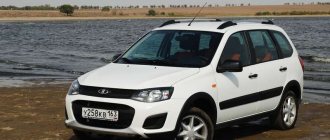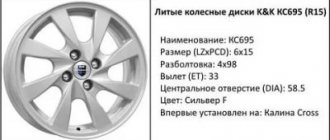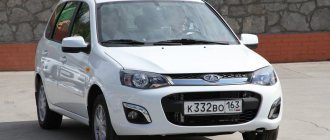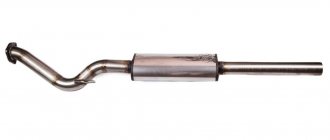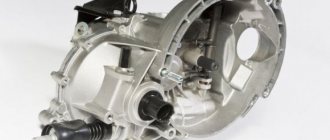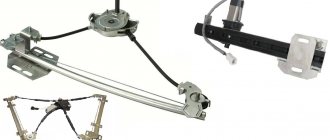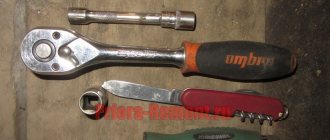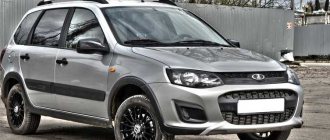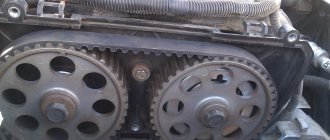When comparing the Datsun mi-DO and Lada Kalina, car enthusiasts are faced with a difficult question: “Which hatchback is better?” Indeed, in fact, one of the cars can easily surpass the other in some parameters, but be noticeably inferior in the rest. For example, the domestic Lada is superior to Datsun in practicality and more powerful power units, but inferior to it in equipment and style.
The choice between Mi-DO and Kalina is complicated by the fact that the cars have approximately the same price category.
Lada is inferior to Datsun in prestige
You shouldn’t think that the Japanese are superior in popularity to the domestic representative. Both cars are assembled at identical rates and roll off the assembly line of the same plant. But the psychology of the Russian consumer is built a little differently and when choosing a car, it leans towards foreign cars. Consequently, when choosing a more prestigious vehicle between the Datsun mi-DO and Lada Kalina, the consumer gives preference to Japanese roots.
Almost "jeeps"
There is more in common between on-DO and Cross than it seems. Since Datsun is “Japanese” by name, but is based on the VAZ front-wheel drive Kalina/Grants platform and is registered on the assembly line in Tolyatti. Even though the sedan is formally deprived of increased ground clearance and plastic shields, the numbers say that it has no less off-road features. If under the steel sheet of the Lada engine compartment we measured almost 19 cm, then under the same on-DO power protection the ground clearance is only a centimeter more modest. Yes, the sills and bumpers hang a little lower, the rear overhang is longer, but compared to other state-owned cars, Datsun is by no means a pushover, and is not afraid of primers
.
Let’s even strengthen it: he loves on-DO graders and country roads, since the energy intensity of his suspension is higher than that of the Cross! And this is a serious request, because Kalina is indifferent to broken surfaces. But if the chassis of the Lada sometimes upsets you with knocks at the end of the day, then the Datsun silently bears the kicks of the road, no matter how you drive it. Except that it starts to shake passengers more intensely as the speed increases.
Lada Kalina Cross
Datsun on-DO
Differences in Exterior
The aggressive look of Kalina's air intake takes up a large space in the front of the car. The hatchback looks confident from the front, having a narrow and long radiator grille, stylish head optics and modest fog lights. In profile the car is less swift and aggressive. The stern looks frankly modest: decorated with reflectors and oblong feet.
In comparison of the hatchback bodies of the Datsun mi-DO and Lada Kalina, the second representative looks more efficient.
Datsun has not stepped forward far, but in some nuances the differences are noticeable. The front of the car does not look as efficient as that of the Russian representative, but the combination of a hexagonal air intake near the radiator grille is well chosen. The chrome surround of the grille clearly completes the exterior composition. Looking at the Datsun mi-DO and Lada Kalina in profile, there are no significant differences, and relative to the stern, the difference is noticeable only in the configuration of the rear door.
Datsun mi-Do. How is it better than Kalina?
Datsun is keeping its promises: following the On-Do sedan presented about a year ago, a second model entered the market - the compact urban hatch mi-Do. In addition to the body type, there are also technical differences from on-Do, for example, the ability to install an automatic transmission. What else will mi-Do try to charm Russians with?
An ordinary miracle
Even with just one model, the Datsun brand is working wonders in Russia, gripped by a currency crisis. Thus, in January, the on-Do model took seventh place in the popularity rating, and this is in the fifth full month of sales, when the dealer network is still 30% staffed.
And here is the first expansion of the model range. The donor for the mi-Do model is even easier to guess - in the front-side view, the Lada Kalina is unmistakably recognizable, the face of which has been slightly scowled, and the rear lights have been painted differently and a couple of wrinkles have been added to the fifth door. Externally, if you want, it’s just a restalling of the VAZ model. What about internally?
The method of manufacturing the mi-Do hatch is in many ways similar to the recipe for transforming a Lada Granta into a Datsun on-Do. Actually, work on the projects proceeded in parallel, and technically both Datsuns are as close as possible.
There are no global differences from donors: the platform, engines, gearboxes, and electrics are almost identical. The differences are the result of the careful work of an international team of engineers to find and eliminate annoying little things that usually bother Lada owners.
For example, brakes. Datsun uses different, more “tenacious” pads, a TRW vacuum booster and special anti-noise plates that reduce brake squeaking. Looking ahead, we will say that it was not possible to completely stifle the song of the brakes: at very low speeds, they no, no, and they will whistle.
Power comparison
Lada Kalina is the undisputed leader in this regard. The car has twice as many power units. Absolutely all engines have a volume of 1.6 liters. If there is an injector and an in-line arrangement, the power of the units may vary noticeably.
Datsun mi-DO has engines of 82 and 87 horses, while the first option is eight-valve. The power limit of the power units is reached at 5100 rpm, while the power thrust is 132 and 140 Nm (3800 rpm).
Lada Kalina does not have an 82-horsepower engine in its collection. But it has more powerful representatives - an engine of 98 horsepower has 5600 revolutions and a thrust of 145 Nm (4500 rpm) and an engine of 106 horsepower has 5800 revolutions and a thrust of 148 Nm (4000 rpm). There is also a sports version of the engine, which has an output of 118 horses (6750 rpm) and a torque of 154 Nm (4750 rpm).
Lada Kalina has more powerful engines, which outperforms its competitors in terms of power.
Interior similarities
Both representatives have tangible similarities in the interior. The developers didn’t try to be too clever and designed the Datsun mi-DO following the example of the Lada Kalina, as they say, “let’s go with the rules.”
On the front panel, common lines are noticeable - three-spoke steering wheels, similarities in the configuration of the center console, the style of the instrument panel, cup holders, air deflectors, the glove box, and the location of the controls.
The compared Datsun mi-DO and Lada Kalina models have well-profiled seats, but lateral support is frankly lame in both versions. Both cars boast comfortable rear seats. There is also a high roof, which will allow passengers not to rest their heads on the ceiling.
test drive on the Women's car portal Careta.info
The revived Datsun brand in Russia, if not breaking records, certainly does not look pale: sales of on-Do and mi-Do are at a very good level, despite all the skeptical remarks addressed to them and comparisons with Lada. The brand itself was “pulled out of the bins” of Nissan, where it had lain for almost forty years. In those years, it was the main brand of the company, later known as Nissan, and cars under this brand managed to travel on the roads of Russia in the early nineties. Its revival as a budget localized brand is a good sign: it means that Renault-Nissan is ready to use the fruits of Russian engineering under its own brand, albeit not the main one, after some modification.
The comparison of the car with the Lada Kalina is obvious, but Datsun should not be considered just another modification of it. Modern cars differ from each other in nuances, in prioritization and execution details, so in mi-Do there is a slightly different atmosphere, an attempt to make the car “more different”, first of all, more Japanese. And don’t be misled by changes in appearance: unlike the old Soviet school of “modernization,” when the car’s plumage and external panels changed over and over again, leaving its essence unchanged, here the appearance was changed not at all for show and “mastering a new model by the XVIIIIIIIIIIIIIII Congress of the CPSU,” but just to emphasize that the car is now completely different. Yes, it was not possible to hide the relationship, but such a task was clearly not set. Judging by the reviews of those who were involved in fine-tuning this car, the goal was different - to change the approach to quality of workmanship as much as possible, increase reliability and give the car more thoroughbred driving habits.
As for reliability, they clearly decided to take the reinsurance route. The most reliable and simplest of the entire line of VAZ engines is the eight-valve 11186 with a power of 87 hp, the Japanese Jatco automatic transmission and the complete absence of any complex units, proven components and selection of suppliers to ensure maximum quality performance. I would say that for a cheap car it turned out well, the only serious irritants in the cabin were the inexpensive seats, the sound of the turn signal beeper and the somewhat strange working brakes, however, the latter is clearly a feature of a particular instance.
The rest of the interior is even pleasant: it does not rattle too much, is made of cheap but not irritating materials, and has a clear instrument panel. It is not too different from the platform Kalina, but there are fewer minor assembly flaws that manifest themselves in the form of clicks or poor operation of covers, latches and handles. In the future, the differences will disappear - according to the agreement between the companies, all Datsun innovations will be implemented on Kalinas, which means that all the pleasant changes will appear on Ladas very soon. And the main change that is worth waiting for is noise insulation; oddly enough, the new approach is making itself felt. No, the car has not become a “six hundredth” and is even far from any Octavia, but obvious flaws have been removed in the form of noise from the wheel arches and increased noise in the rear seats, interior creaks and knocks, even the rear wiper is now quiet. The engine sounds as usual, maybe a little muffled, but the new automatic transmission is responsible for the complete absence of transmission noise; with it, the quiet howls so familiar to all VAZ drivers, which are especially annoying when braking the engine, disappear. Otherwise, we can hope for work on selecting component suppliers and improving the painting process, changing the range of steels used for body production and other seemingly subtle changes. Unlike garage tuning products, ease of maintenance and weight of the car are taken into account.
Complete sets at one price
In approximately the same basic configurations, the Datsun mi-DO is superior to the Lada Kalina. In terms of safety, the Japanese hatchback is better equipped. In addition to the standard elements for most B-class models (ISOFIX mount, electric front windows, central locking, radio preparation), for the same money the Japanese is equipped with:
- anti-lock braking system ABS,
- EBD brake force distribution,
- EBA emergency braking assistance system.
In more advanced configurations, both Lada Kalina and Datsun Mi-DO cars boast:
- a pair of front airbags for safety (Datsun has additional side airbags),
- ESP stabilization system,
- fifteen-inch wheels,
- fog lights,
- electrical package,
- air conditioning (MI-DO has climate control),
- heated mirrors and seats,
- parking sensors,
- navigation,
- audio systems with displays and other options.
In price comparisons, the Datsun mi-DO slightly outperforms the Lada Kalina.
“Japanese quality” Datsun – is it really different from Granta and Kalina?
SKP means “assembly and body production”. SKP "Kalina" is a building at AVTOVAZ, where the assembly line of Lada Kalina, Lada Granta, Datsun on-DO and Datsun mi-DO cars is located. Four models, two body types, one platform and... two different brands - Russian and Japanese. This production is relatively young, it was launched along with the first generation of Kalina. And not so long ago it went through a real rebirth: the Japanese and French who came to the plant wanted to use the Russian Lada Kalina platform to produce their own model. The conditions were mutually beneficial, but at the same time the foreigners demanded that the VAZ team comply with a whole system of their own standards.
– Alexander, has anything changed in your estate over the past couple of years?
— Two years ago, our body geometry was at the level of 75% - this is the number of control points that fit into the tolerance. A group of geometers was organized, which analyzed the geometry of the body, implemented activities and monitored the results. At the moment, the body geometry is at the level of 95-96% within the tolerance. This is a fairly high level, the same at Alliance factories. Now this group has gone to Izhevsk to launch Lada Vesta there in order to provide assistance in improving the body geometry. And, as far as I know, this work has already produced a positive result.
We understand that quality is created in the workplace, so our focus is our workplaces. This is operator training that we conduct upon hiring or transferring to work with us. We have a mastery school where the operator receives basic knowledge. If this is an operator who is engaged in assembling a car, then these are mainly wrapping operations. If this is a painting operator, then this is the application of mastic and base enamel. If this is a welder, then these are points during resistance welding. Next, the worker comes to his workplace, and the master continues his training, giving the basics of what will happen at the workplace, because this place has certain standards.
– Since we’re talking about percentages and indicators, please share why in the last year and a half the percentage of direct scrapping of cars has increased so much (the percentage of cars that do not require modifications after the assembly line - editor’s note) in the Kalina workshop.
— Firstly, each group of problems was analyzed, a Pareto chart was compiled (a bar chart that allows us to identify the most significant causes of marriage and determine priority actions to eliminate these causes - editor's note), and we took the most important problems for research. That is, they carried out an analysis, understood the root cause, drew up an action plan, implemented it and tracked the results.
The QRQC technique (methodology for quick response to quality problems - editor's note) has been very helpful in solving many problems. These are daily meetings that are held at three levels: at the level of the plant director (where I am an active participant and, in fact, I lead these meetings), at the level of the production manager (we have three production facilities, respectively, three meetings daily) and at the level of supervisors workshops (about 8-10 workshop heads). Thus, in one day we cover more than ten problems that are solved simultaneously.
Source: www.kolesa.ru

